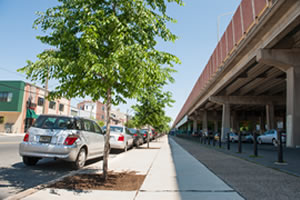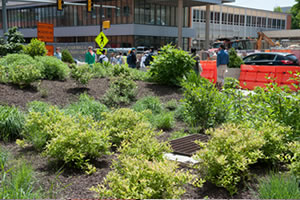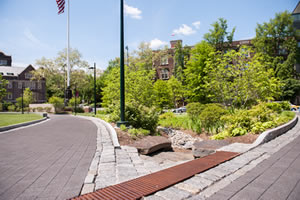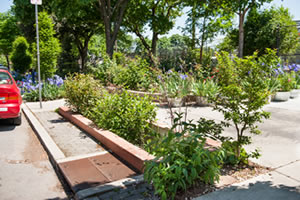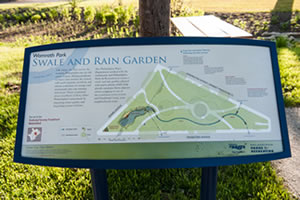Why Philadelphia is shifting perspectives on stormwater management
Mark Maimone, CDM Smith
Green stormwater infrastructure (GSI), also known as sustainable drainage systems (SuDS), is rapidly becoming an accepted, popular way for cities to address stormwater and combined sewer overflow (CSO) control problems. A new, alternative approach to stormwater management in urban areas, it refers to numerous strategies for handling storm precipitation before it has entered a sewer system. It can mean using natural systems such as vegetation, wetlands and open space, but can also involve engineered solutions like rain gardens, rain planters and barrels, tree pits and permeable pavement.
The Philadelphia Water Department, faced with a mandate to reduce CSOs into its rivers and creeks, found it critical to approach the problem in the context of the city’s economic, social and environmental challenges. After expanding its analysis of potential ways to reduce CSOs, the department chose a GSI approach over more traditional engineered solutions, such as tanks and storage tunnels. GSI could help filter water, slow runoff, cool local and regional urban heat effects, and clean the air. Additionally, some GSI practices would support climate mitigation goals by reducing greenhouse gas emissions, enabling community participation through adoption of rain gardens and home-based solutions, and creating local jobs.
An overview of Philadelphia’s initial steps to implement this change is presented in the video on the Green City Clean Waters program. This 25-year program is designed to provide many benefits beyond reduced CSOs, so that every dollar spent maximizes return in benefits to the public and the environment. Using GSI to manage at least the first inch of runoff from every storm on thousands of acres of what are now impervious surfaces will help Philadelphia significantly reduce the amount of stormwater entering its overburdened sewers—also reducing pollution to its rivers and creeks. Managing can mean infiltrating stormwater into the ground using trees and plants to enhance evapo-transpiration, or retention and slow release of captured stormwater back into the combined sewer system to prevent overflows or discharges.
In fact, the department’s new approach is a radical shift in the way cities handle stormwater. The current approach in urban areas around the world reduces and controls pollutants resulting from stormwater runoff through end-of-pipe, command-and-control, fast-conveyance systems, either with combined or separate sewers. The intent is to carry stormwater and sewage as quickly as possible away from the surface and to water pollution control facilities for treatment and eventual discharge to rivers and lakes near the city. By changing its approach, Philadelphia is addressing the total water balance, where all components of water supply, stormwater and wastewater are managed in a closed loop. The Philadelphia Water Department is in year three of its ambitious program—succeeding in the daunting task of implementing Green City Clean Waters. Many cities are watching Philadelphia’s experiment, and there is much to learn from its initial efforts and the benefits of GSI.
Mark Maimone, CDM Smith senior vice president, has over 25 years of experience in water resource planning, groundwater and surface water modeling, and decision support services working for clients both in the United States and abroad. He has worked with the Philadelphia Water Department for 13 years on water supply and CSO planning and is the project manager for their Green City Clean Waters program.
